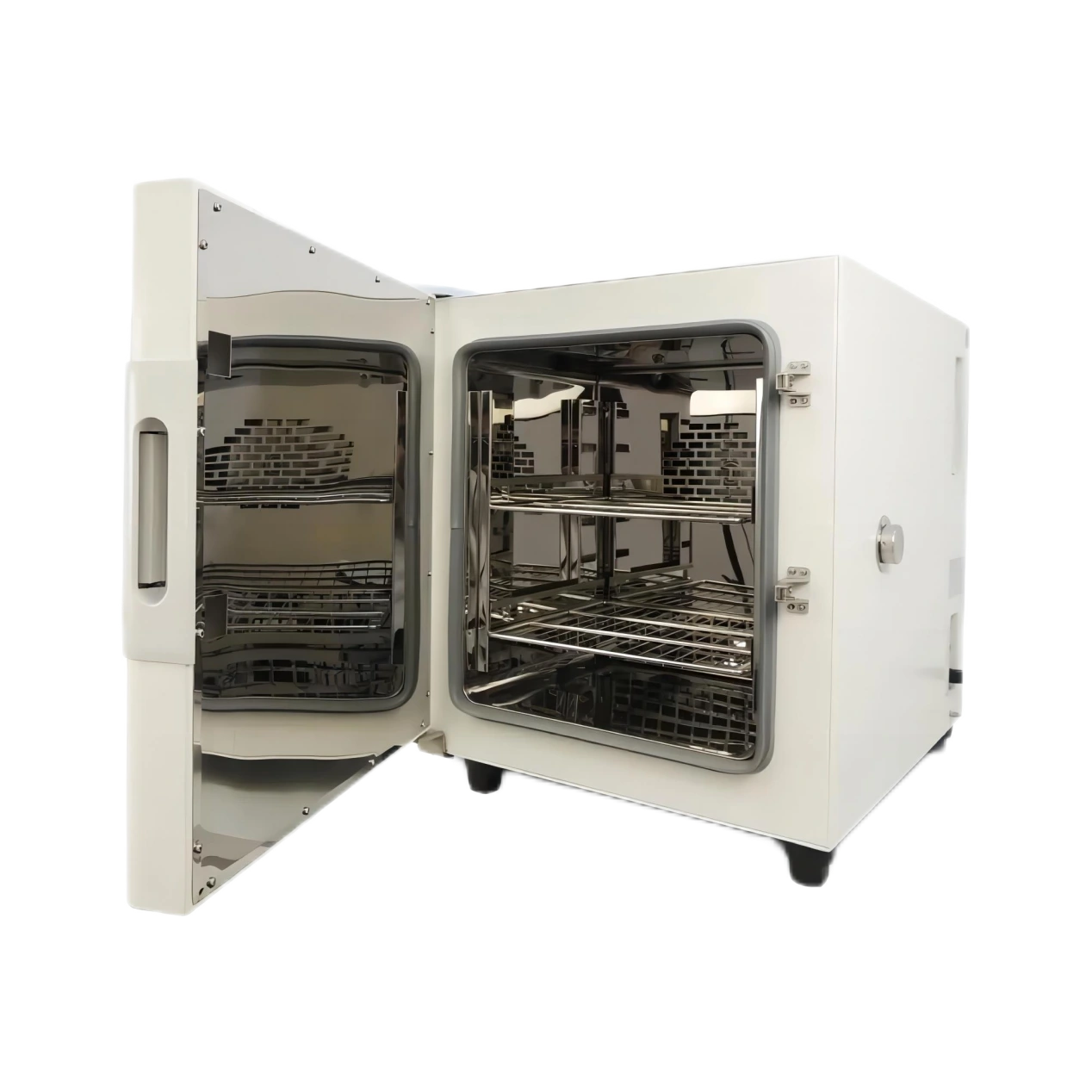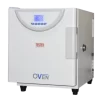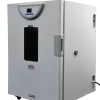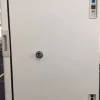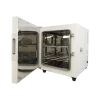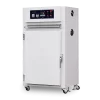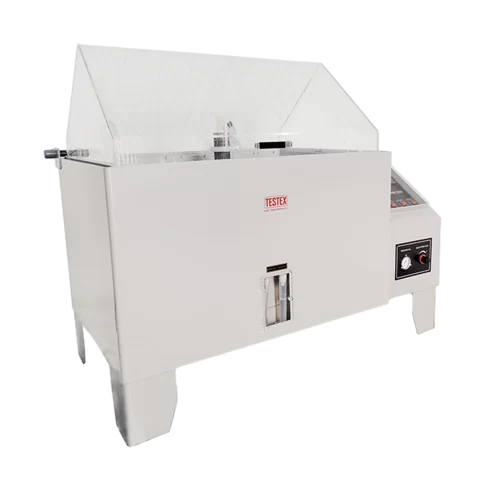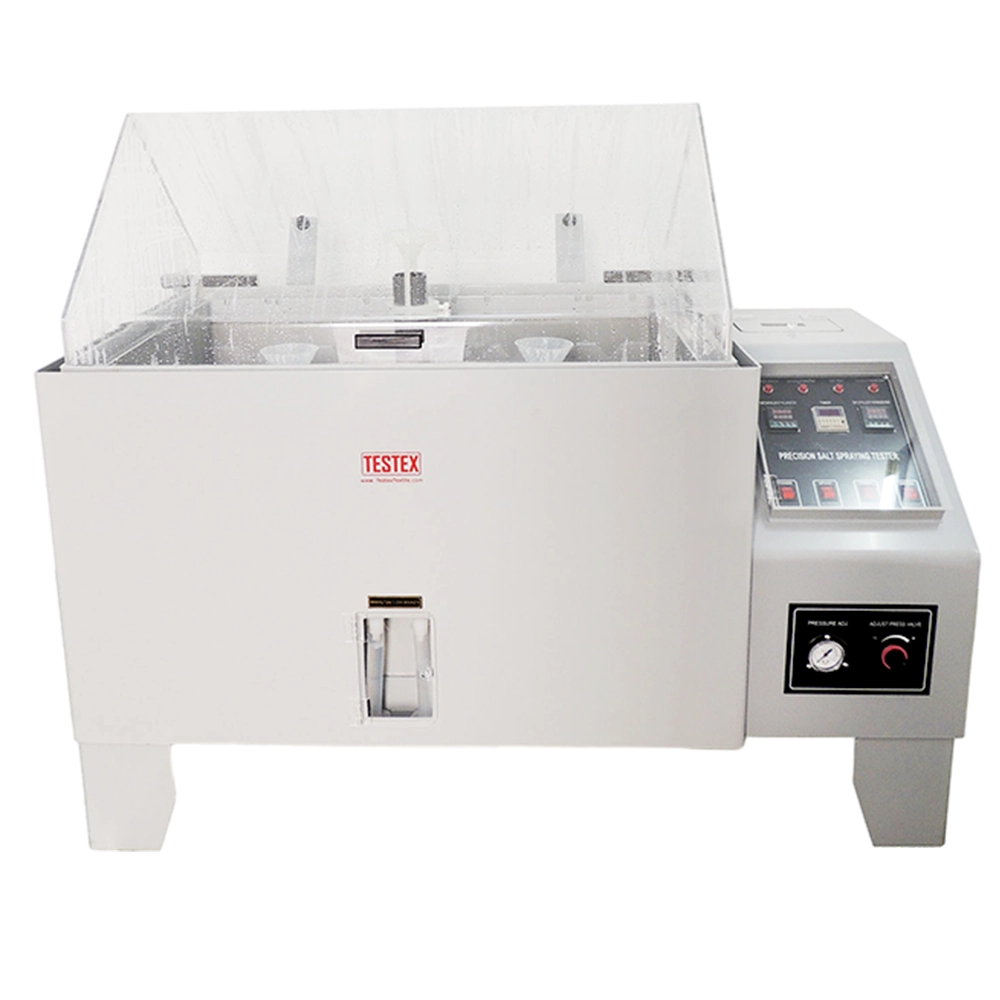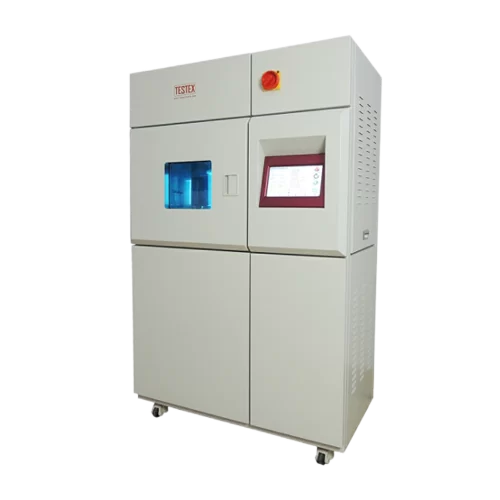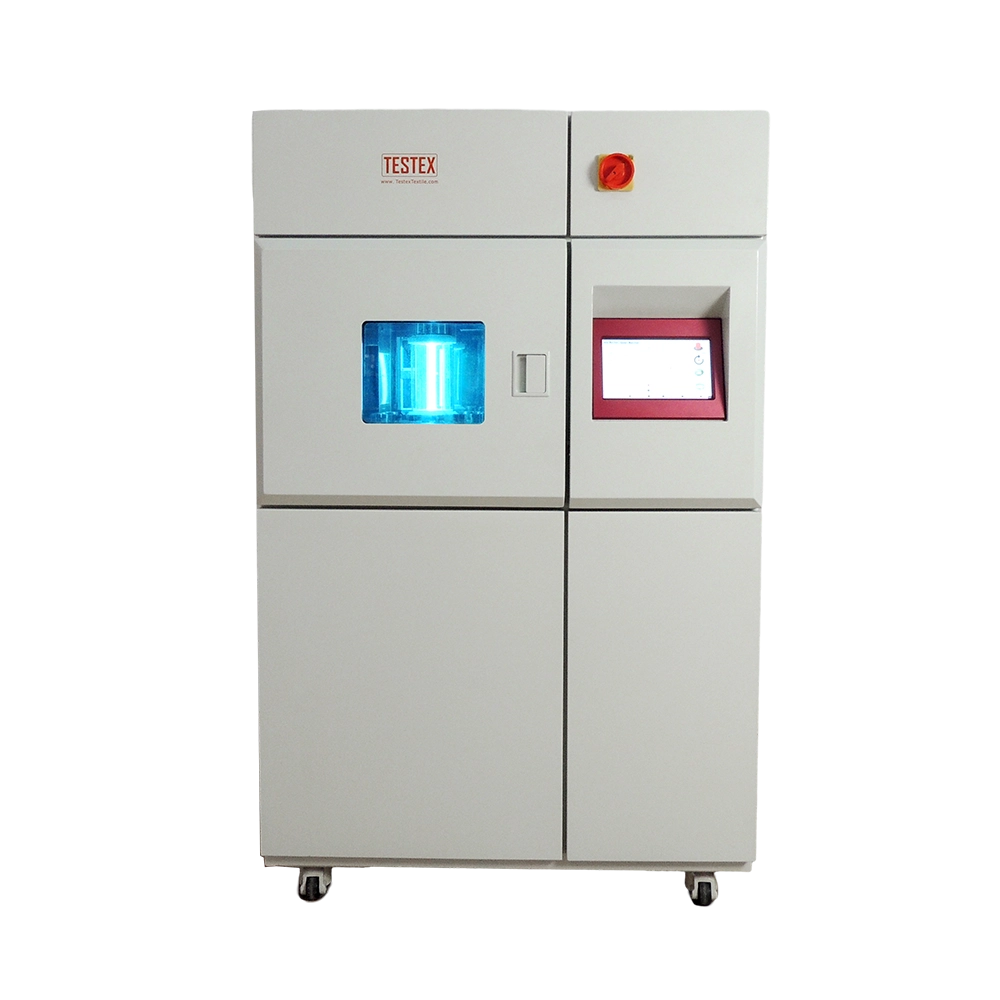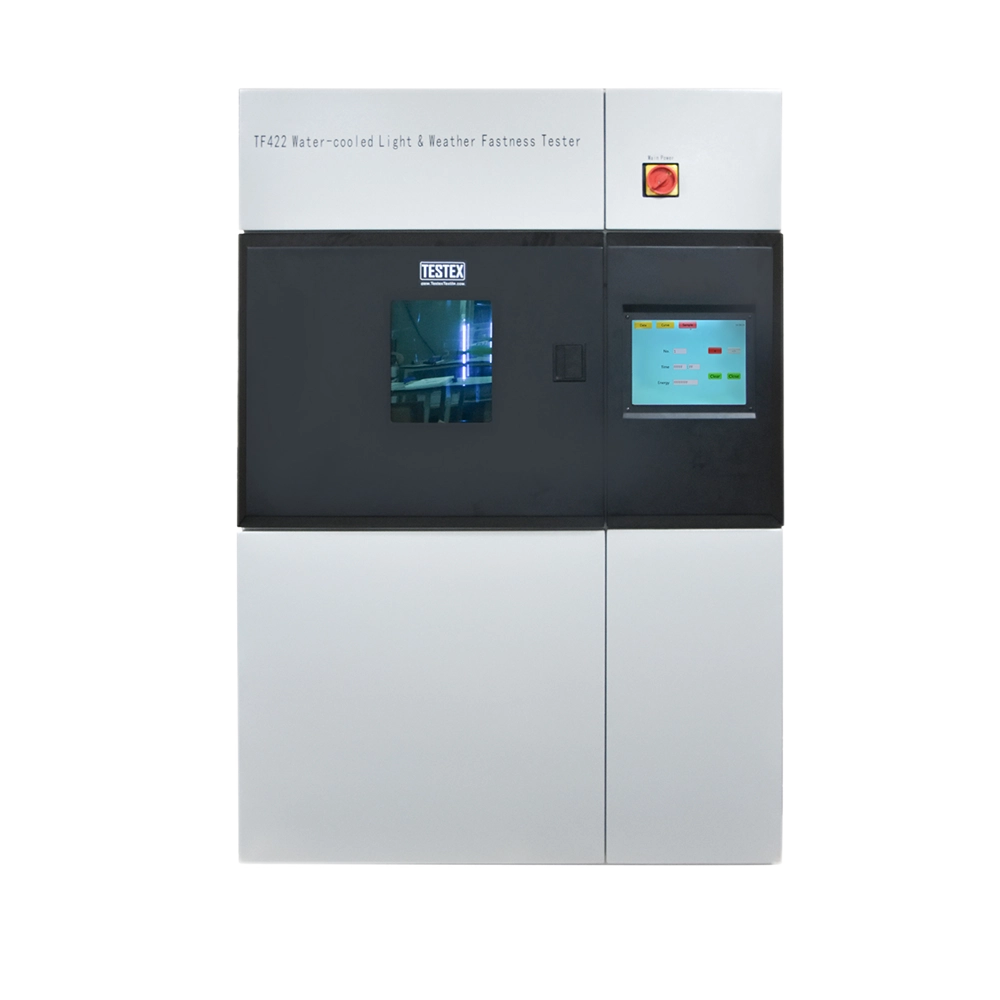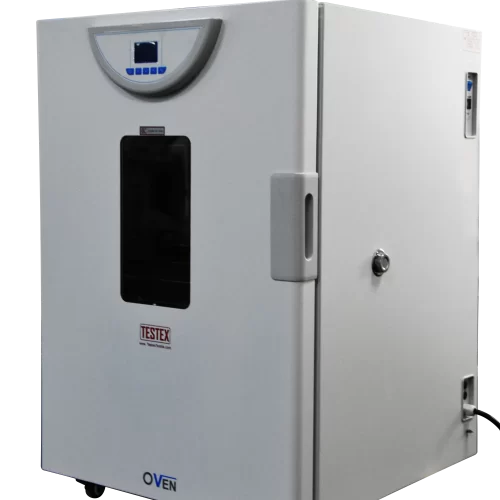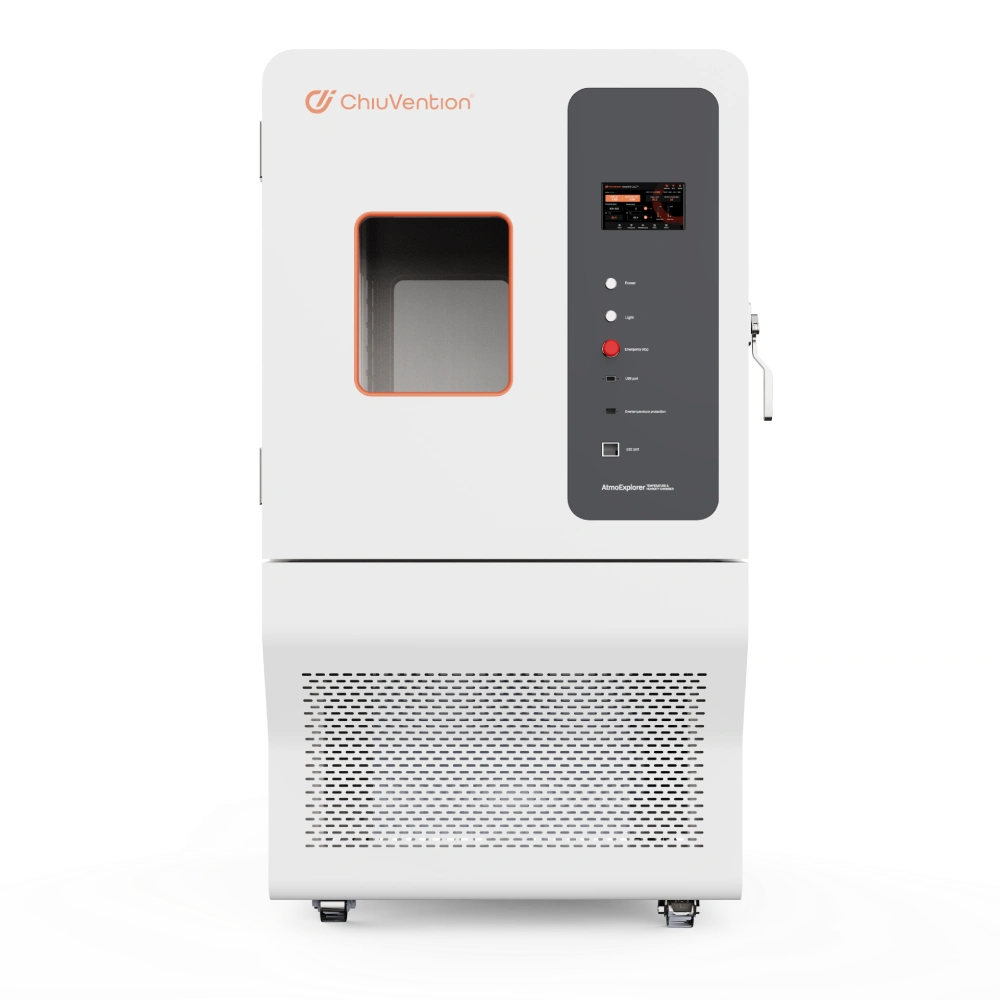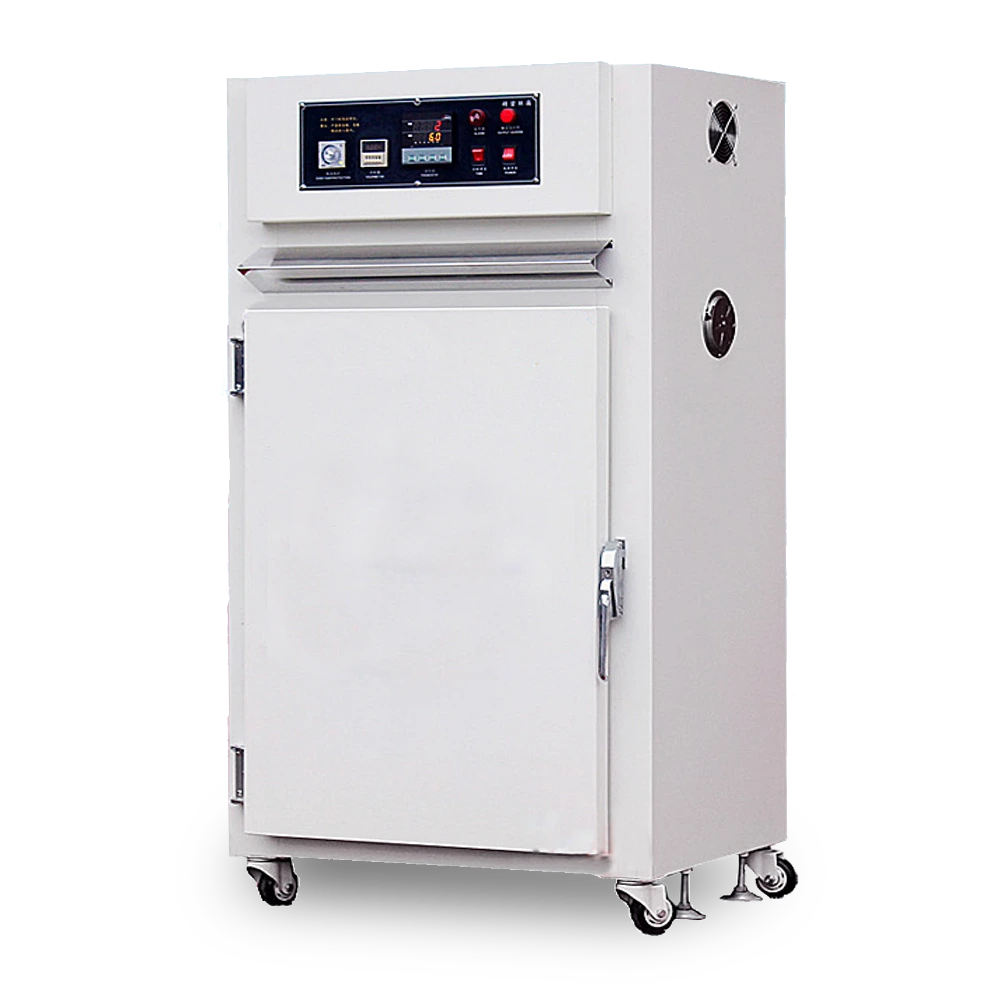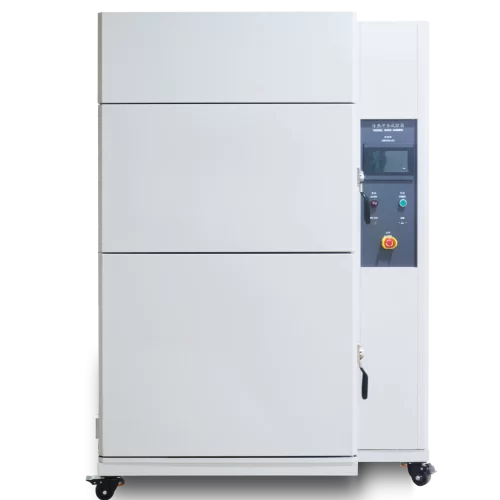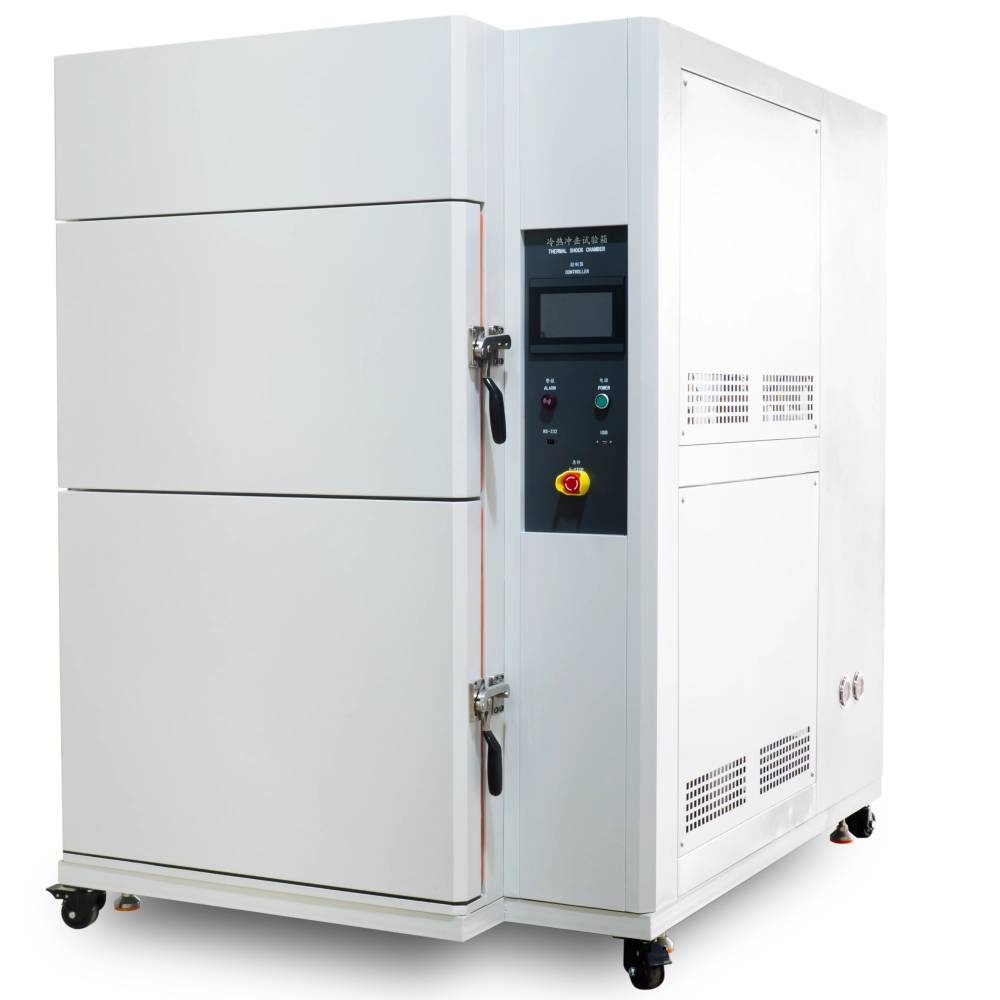the main technical parameters of Laboratory Oven:
| Range: | RT 200℃ |
| Accuracy: | 0.1℃ |
| Ambient Temp.: | +5-40℃, the relative humidity is less than 85% |
| Timing Range: | 1-9999 min |
| Shelves: | 2 pcs (40 L & 70 L), 3pcs (140 L & 240 L) |
| Interior size: | 40L 350*300*400 mm (WxDxH), 70L 400*320*550 mm (WxDxH) 140L 500*380*750 mm (WxDxH), 240L 600*450*900 mm (WxDxH) |
| Power: | 220 / 110 V 50 / 60 Hz |
| 0.85Kw – 40L 1.1Kw – 70L 1.55Kw – 140L 2.05Kw – 240L | |
| Weight: | 40kg 55kg 100kg 180kg |
| Dimensions: | 40L 505*635*600 mm (WxDxH) 70L 560x670x750 mm (WxDxH) 140L 655*715*980 mm (WxDxH) 240L 755*785*1130 mm (WxDxH) |
Lab oven structure and function overview
- The BPG Series Electrical-heating Constant Temperature Incubator has three parts. It has the case, thermal control system, and air circulation system.
- We punch fine-quality steel plates to make the case, plasticizing the surface. For the chamber, we use fine-quality galvanized sheet or mirror-face stainless steel sheet (optional for the customer). We use mineral wool to fill the insulating layer. The box door has a display screen and buttons for temperature control.
- The thermal control system has one main part. It is the thermal controller. It is a digital circuit controller with a CPU. It is called the Thermal Controller for short. The thermal controller has a 70×42mm LCD screen. It shows the screen, PID, time, error, difference, and protection. The Pt100 platinum resistor is the thermal cell. The heating element is from a metal-pipe heater. The thermal controller is part of an enclosed heating control system.
- The air circulation system is composed of fan and air duct. The fan is rotated to circulate cool and hot air. This raises the evenness of temperature in the chamber.
- The product has many advantages. It has high thermal accuracy. It also has less overshoot and fluctuation. It also has differential over-temperature protection. The product’s safety can be raised further to meet the customer’s needs. An independent over-temperature protection system can be added (optional).
Features of Laboratory drying oven
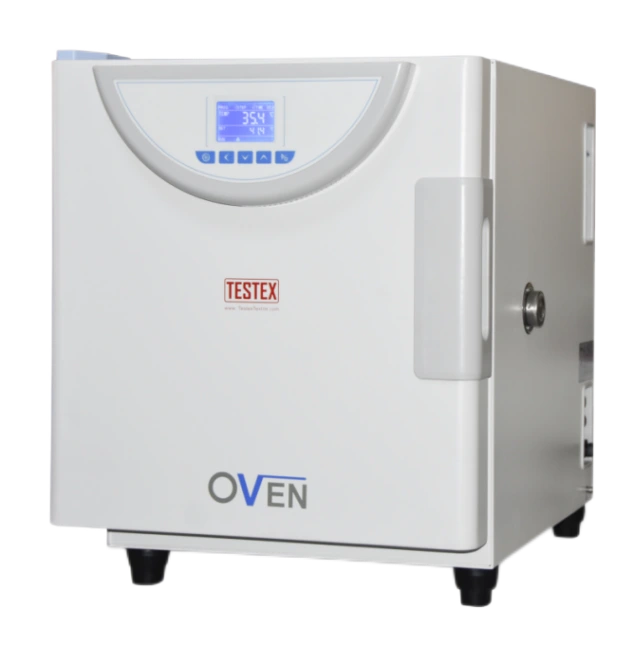
Precise temperature control:
The drying oven can keep a stable temperature. It meets the needs of various applications with a precise control system.
Uniform hot air circulation:
The oven has an internal fan and ventilation system. They enable the circulation of hot air. This improves the drying of materials.
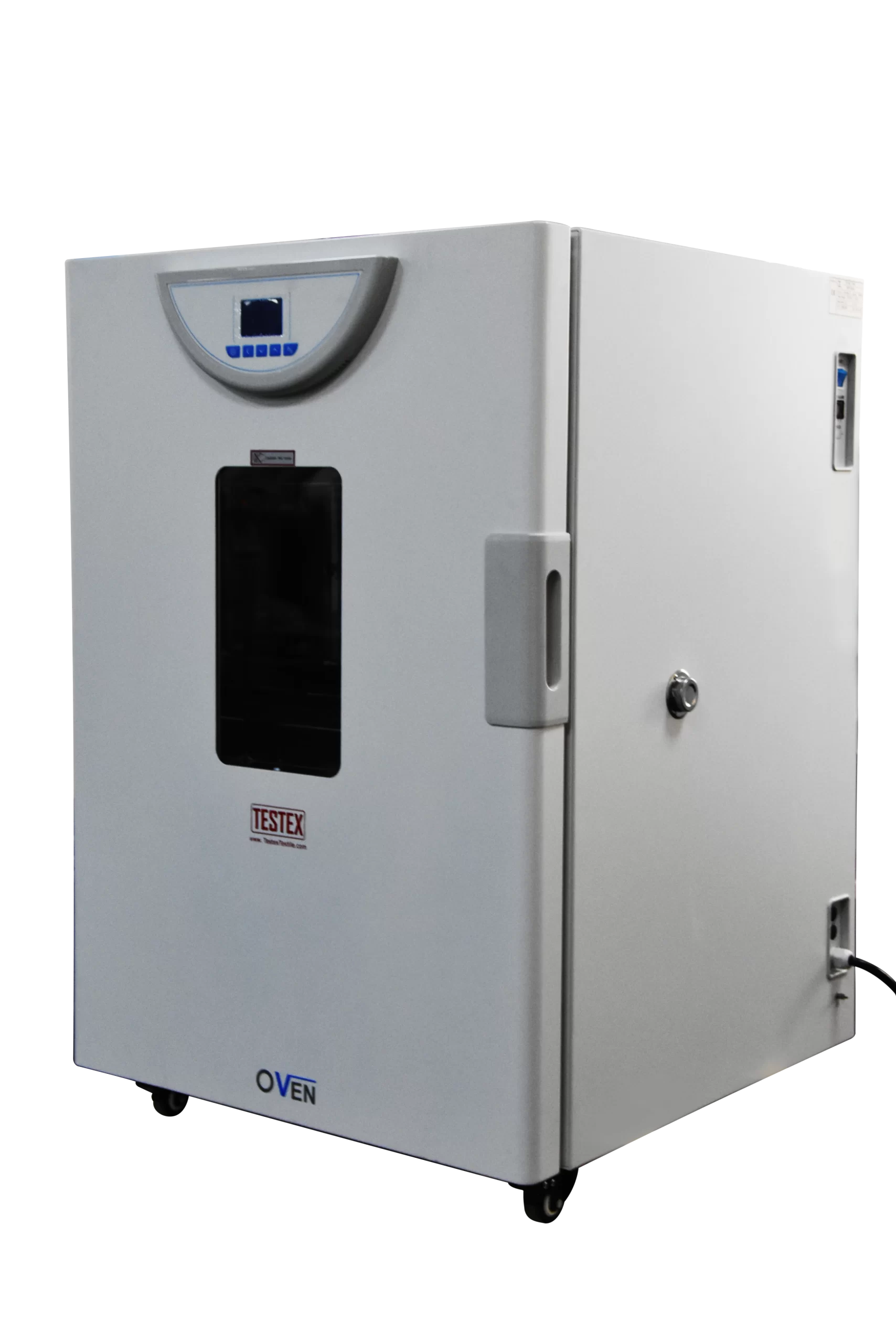
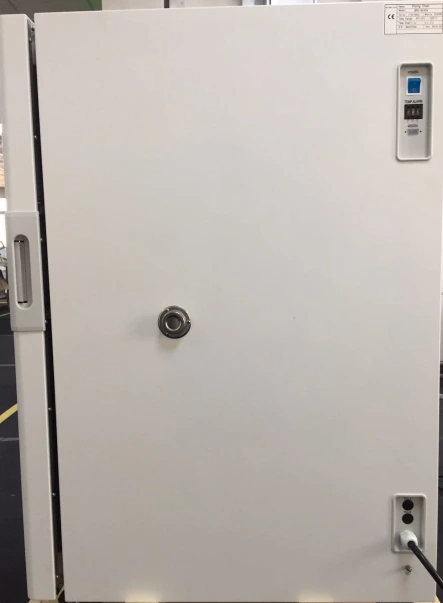
Safe and reliable operation:
The shell is stainless steel. It resists corrosion and lasts a long time. It also has many safety features. These include over-temperature and leakage protection.
Wide range of application:
The lab drying oven is used in many industries. These include medicine, food, chemicals, and electronics. It is used for drying, heating, testing, and baking.
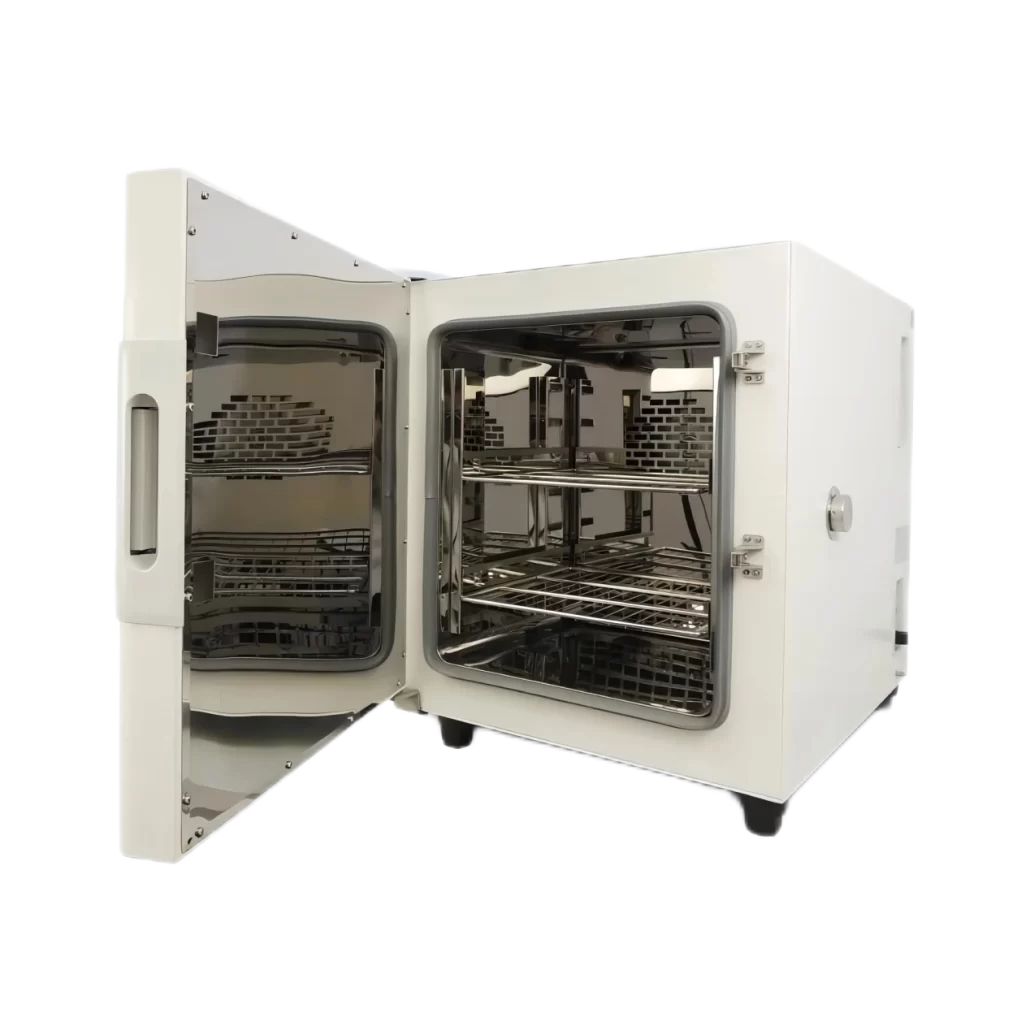
FAQ About hot air oven
Avoid piling up too many samples inside the oven or blocking the vents, as this may affect temperature uniformity and hot air circulation.
Please pay attention to the heat resistance of the samples and the baking temperature limits to ensure that they do not overheat or burn the samples.
Clean the oven regularly, especially the baking trays and vents, to prevent the accumulation of dust and impurities that could affect baking results and oven safety.
Calibrate the temperature control system regularly to ensure the accuracy and stability of the temperature inside the oven.
Various industries, such as chemistry, food, medicine, and so on, use laboratory ovens.
- Scientists in the chemical field use laboratory ovens to dry, cure, and heat organic specimens.
- In the food sector, we use laboratory ovens to bake and sterilize food products such as bread, biscuits, and meat products.
- In the pharmaceutical field, scientists use laboratory ovens to dry and sterilize medicines.
The main purpose of a laboratory oven is to regulate the temperature of the internal air to the required temperature to enable processes such as baking and drying of samples. Laboratory ovens are ovens used to produce a controlled temperature heating environment for sterilisation, curing and evaporation of laboratory functions. Laboratory ovens are usually different from regular ovens where the oven draws in fresh air from the outside, most laboratory ovens recirculate the same air inside the unit and provide specific functions.
- Preheating the oven:
Set the oven to the desired temperature and allow sufficient time for the oven to warm up to a stable temperature. Typically, experts recommend preheating the oven before placing samples. - Sample Placement:
Place the samples in the oven for processing according to the needs of the experiment. Make sure that the sample does not block the oven vents or come into contact with the heating elements. - Set temperature and time:
Set the appropriate temperature and baking time according to the experimental requirements. Follow the experimental protocol or sample requirements to select the appropriate temperature and time parameters. - Observe and monitor:
During the operation of the oven, observe the baking process of the samples periodically to ensure that their condition is as expected. You can use thermometers or temperature loggers to monitor the internal temperature of the oven and ensure stability and accuracy. - Safe Operation:
Follow laboratory safety procedures such as wearing appropriate personal protective equipment (e.g. lab gloves, goggles, etc.). Be aware that the hot surface of the oven may generate high temperatures and avoid touching the heating elements inside. - Finish baking:
At the end of the set time, switch off the oven and remove the samples. Handle hot samples with care to avoid burns.
The basic principle is to use electricity or other energy sources to generate heat. Then, the heater transfers heat to the box to heat and dry the sample.
This seriously breaks the rules of lab operations. It can cause fatal injuries. The lab used the oven for hot food. But, the oven can dry toxic substances. This led to food contamination. So, we must ban eating in the laboratory. This is especially true in chemical and biological labs.
- The box is made of a high-quality cold-rolled steel plate. It is coated with showering electrostatic powder spraying. This makes it more durable and easier to clean.
- The chip is high-performing. It is for CPU processing. The system has a highly sensitive, high-precision platinum resistance sensor. It makes the temperature control more accurate and easier to use.
- We use hot air circulation to make sure the temperature is the same everywhere.
- The studio and the box door connection has a heat-resistant silicone rubber ring. It seals the gap between the studio and the box door.
- The box’s door has double-layer tempered glass. It lets you clearly see the heated items inside.
- The alarm system has a temperature limit. If it goes over the limit, it shuts off. This keeps the experiments safe.
First, their usage scenarios are different.
A lab oven heats and dries objects. It is mainly for drying and storing food, electronics, chemicals, and other items. However, the laboratory incubator is used for biology experiments. It is primarily for growing, multiplying, and storing cells, microorganisms, and biomolecules. It is common in the life sciences.
Second, the temperature control is different.
Lab oven uses a mechanical or electronic thermostat to control temperature. It makes the air inside reach the set temperature. The lab incubator needs more precise temperature control. It uses an advanced microcomputer temperature system to achieve this. The system can control the temperature more accurately.
Third, the humidity control is different.
Lab ovens do not need to control humidity. They do this by heating to improve the temp and humidity inside. The lab incubator needs to control humidity well. This ensures the normal growth and reproduction of cells and microorganisms. So, the incubator uses an advanced humidity system. It can effectively control humidity.
Fourth, the structure and material differences
Lab ovens are usually made of stainless steel or iron. They have strong, heat-resistant textures. They have a single or multi-layer structure inside. The incubator is usually made of high-quality engineering plastics or stainless steel. They have better corrosion and rust resistance. The internal structure is usually multi-layered, so they are easy to store and manage.
- Regularly clean the inside and outside of the drying oven: use pure water and detergent to wipe away dust and stains on the drying oven. Try not to use cleaners containing acid or alkali components.
- It is recommended to use a protective cover: the drying box will have a lot of dust and dirt gathered inside. It is recommended to set up a protective cover above the drying box to avoid the dust deposited on the drying box from entering into the interior of the drying box to affect the drying effect.
- Check the electrical components: check whether the electrical lines and electrical components of the drying box are operating normally, confirm that the electrical parts are operating normally, and it is better to do electrical safety check and insulation resistance test once a year.
- Replacement of heating elements: replacement of the countertop oven can greatly extend the service life of the drying oven and improve the efficiency of the work, it is usually recommended to carry out centralised maintenance once every three years.
- Maintain the fan: the fan of the drying oven needs regular maintenance, cleaning the fan and its dust film can ensure its normal work.
- Maintain the environmental quality of the drying box: the importance of the indoor environmental quality of the drying box is very great, especially for the use of some high-precision instruments, so it is necessary to clean and maintain the filter of the drying box on a regular basis to ensure its filtering effect.
- Record the maintenance record at any time and maintain it according to the manufacturer’s suggestion: Record the maintenance time of the drying oven correctly every time and what operations are carried out, and maintain the drying oven according to the maintenance record of the drying oven in order to prolong the service life of the drying oven.
- Should work indoors and installed smoothly.
- The power input should be equipped with a special front-level on-off switch, and connected to a good ground.
- Must check the power supply, voltage, power supply wiring is correct, before powering on the use.
- In the idle for a long time after use, should be used first low-temperature (80-100 ℃) baking two hours before starting to raise the temperature, can extend the service life of the test chamber.
- The initial use, should be observed diligently, to avoid overheating baked bad workpiece, resulting in losses.
- Use such as thermal inertia is slightly larger, you can turn off a group of heaters to reduce the heating power, to prevent inertia caused by too large temperature.
- Take and put the baking objects: please do not hit the studio part of the thermostat, to prevent damage to the thermostat leads to failure.
- The box should not bake explosive, flammable and volatile substances to prevent explosion.
- Preparation. Ensure that the external environment of the oven is dry and clean, and the interior is clean and free of odour. Check whether the power connection is normal.
- Place the oven. Place the oven on a stable lab bench or on the ground, avoid direct sunlight, and make sure the air inlet and outlet are not blocked.
- Set parameters. According to the experimental requirements, set the oven temperature and time. The temperature is generally set at 100 ℃ to 300 ℃, the time is determined according to the characteristics of the sample.
- Preheat the oven. Preheating time is usually about 30 minutes, preheating the oven door should be completely open, so that the hot air circulation, and set the temperature to the highest.
- Place the sample. Place the samples to be dried in the oven, paying attention to the spacing of the samples to avoid blocking the vents or contact with the heating elements.
- Close the oven door and start the oven. Before closing the oven door, check whether the door lock is properly locked, start the oven, adjust the air duct and temperature as needed.
- Monitor the oven. During the operation of the oven, regularly observe the status of the samples and use a thermometer or recorder to monitor the internal temperature of the oven to ensure its stability and accuracy.
- End baking. When baking is complete, open the oven door and wait for the samples to cool to a safe temperature before removing them.
- Cleaning and Maintenance. Clean the dust and debris inside and outside the oven, and carry out regular maintenance to ensure the cleanliness and safety of the oven.
Whether a laboratory oven can be left on overnight depends largely on the model and quality of the oven and the specific requirements of the experiment. High-quality laboratory ovens can usually be operated continuously for more than 8 hours, with stable performance at temperatures above 25°C. Most ovens have an upper limit of 24 hours of use, during which time the time of use can be freely adjusted according to the needs of the experiment, but the use of the equipment must be strictly adhered to.
It is important to note that when using a laboratory oven, the temperature should be controlled within a safe range, usually recommended between 40°C and 60°C, to avoid exceeding 60°C may produce harmful gases or the risk of fire. In addition, the safety performance and operating condition of the oven should be checked regularly to ensure that there are no faults or safety issues. During use, avoid switching the oven on and off frequently to avoid damaging the equipment, and ensure that the room is ventilated to prevent the room temperature from becoming too high.
However, it is not recommended that the oven be used continuously during sleeping periods as prolonged use may result in excessive energy consumption, burnout of the unit, and safety hazards. If more than 24 hours of use is required, equipment maintenance should be carried out first and advice should be sought from the manufacturer of the equipment as to whether it is possible to extend the period of use.
In conclusion, laboratory ovens can be used continuously overnight, but for safety and long-term performance of the equipment, the operating instructions should be strictly followed, taking into account the specific needs of the experiment and the specific conditions of the oven.
1. Different fields of application.
Biochemical incubator is biology, genetic engineering, medicine, health and epidemic prevention, environmental protection, agriculture, forestry, animal husbandry and other industries, scientific research institutions, colleges and universities, production units or departments of the laboratory of the important experimental equipment, generally used in enzymology and enzyme engineering research; biology, medical products, vaccines, blood and a variety of specimens and the preservation of the aging test and other uses of the constant-temperature test; can be widely used in low-temperature constant-temperature test, culture test, environmental test, etc.. test, culture test, environmental test and so on.
Constant temperature incubator is mainly for health care, pharmaceutical industry, biochemistry, industrial production and agricultural science and other scientific research departments.
2. Different control precision.
Biochemical incubator is mainly used for biochemical reaction incubation. So their doors are mainly composed of glass, for incubation reaction at a specific temperature, the operator can not destroy the reaction conditions under the premise of the reaction outside the observation of changes in the reaction, can be used for bacterial mould and control of bacterial culture. The constant temperature and humidity incubator is mainly used for the cultivation of bacteria and control bacteria, its sealing is good, the temperature and humidity are controllable and constant, but not easy to observe outside.
3. The temperature control range is different.
Biochemical incubator and constant temperature incubator temperature control still has a small gap. Top Instruments SPX-150 biochemical incubator, for example, the product is equipped with a refrigeration system, the temperature range of 0 ~ 50 ℃. The normal thermostatic incubator is usually room temperature +5 ~ 60 ℃ or so, and biochemical incubator precision than the precision of the thermostatic control box.
4. The price of the product is different.
Generally in the same size of the biochemical incubator and thermostatic incubator, biochemical incubator price is higher than the thermostatic incubator. This is determined by the performance of all aspects of the product, quality and other factors.
Methods of cleaning a lab oven include using white vinegar, dishwashing liquid, baking soda, alcohol, lemon + alcohol, etc.
Using white vinegar and water: Mix white vinegar with water in the ratio of 1:1, put it into the oven, set the oven temperature to 180° and heat it for 15-20 minutes, then wipe it with a damp cloth.
Use detergent: Mix detergent with water at a ratio of 1:10, spray the inside of the oven, then place in the oven with a large bowl of boiling water, close the door and leave for 10 minutes, then wipe with a damp cloth.
Use baking soda: Mix baking soda with water to form a paste, apply to the inside of the oven, leave for 1 hour and then wipe.
Use Alcohol: For grease stains, spray with medical alcohol and wipe gently.
Use Lemon + Alcohol: Make your own lemon alcohol by mixing lemon zest with alcohol and use it to wipe down grease stains.
These methods can be chosen depending on how dirty the oven is and the materials available. For particularly dirty or clumpy ovens, liquid cleaners may be necessary, but care should be taken to choose a cleaner that does not abrade the protective sealant. Additionally, purchasing an oven with an easy-clean feature is a simple and effective option.
The method of regulating the temperature of a laboratory oven involves the following steps:
Switching on the main power switch: firstly, make sure that the main power switch of the laboratory oven is switched on, this is the first step in starting the oven.
Temperature Setting:
Top Temperature Setting: The temperature setting can be switched on/off by pressing the ‘Top Setting’ button or using the ‘I/O’ button. Use the ‘▲’ button to turn up the preset temperature and the ‘▼’ button to turn down the preset temperature. The range of the set temperature is usually 0-300°C.
Lower Fire Temperature Setting: Similarly, the same ‘▲’ and ‘▼’ keys can be used to adjust the lower fire temperature by pressing the ‘Lower Fire Setting’ key. ‘keys to adjust the temperature of the lower flame.
Bake Time Setting: After pressing the ‘Bake Timer’ key, you can use the ‘▲▼’ keys to change the time value, the time range is usually 0-99 minutes.
Steam preheat: If you need to use the steam function, you can turn on/off the steam preheat function by pressing the ‘Steam On/Off’ key.
Steam spray time setting: When the steam temperature reaches the preset value, the ‘Steam Spray’ indicator will light up to indicate that steam can be sprayed. By pressing the ‘Steam’ key, you can start/stop the steam timer and use the ‘▲▼’ keys to change the value of the steam time, the range is usually 0-15 seconds.
Caution:
Ensure that safety regulations are followed during operation, e.g. do not touch the heating element.
Adjust the temperature and time settings according to the experimental requirements to ensure that the experimental items can be properly treated or baked under the set conditions.
When using the steam function, pay attention to steam emission and safety to avoid burns or other safety accidents.
Through the above steps, the temperature and other relevant settings of the laboratory oven can be effectively adjusted to meet various experimental or baking needs.
The following key factors should be considered when choosing a laboratory oven:
Capacity: for laboratory use, it is recommended to choose a high-capacity oven in order to bake more food at once and increase efficiency. Large capacity ovens are able to meet the batch processing needs of the laboratory and ensure that the progress of experiments is not limited.
Heating method: It is recommended to choose an oven that heats evenly, such as top and bottom heating type or forced convection type, to ensure even baking of food and avoid overheating or undercooking of certain parts. Such heating method helps to maintain the consistency and quality of food.
Liner material: Choose liners made of harmless materials such as stainless steel or ceramic to ensure healthy food. These materials are not only resistant to high temperatures, but also easy to clean and maintain the original flavour of the food.
Functions: Multi-functional ovens, such as those with functions such as baking by appointment, roasting and defrosting, can greatly enhance ease of use. Such ovens can adapt to different experimental needs and improve work efficiency.
Brand and quality control: Choose products from well-known brands, which usually have better quality control and after-sales service to ensure the smooth running of experiments.
Budget: Choose the right oven according to your lab’s budget. While high-end ovens may offer more features and better performance, basic models can also meet most experimental needs; the key is to find a balance between performance and budget.
To summarise, when choosing a laboratory oven, factors such as capacity, heating method, liner material, features, brand and budget should be taken into account to ensure that the oven you buy meets your laboratory’s needs and improves the efficiency and quality of your experiments.
Although laboratory ovens are subject to strict quality control, prolonged use can still pose certain risks. Common risks include:
- Unstable Temperature: When the oven is run for a long period of time, unstable temperature may lead to biased results.
- Heat Source Depletion: prolonged use may result in excessive heat source depletion, causing the oven to overheat or fail to reach the set temperature.
- Mechanical failure: long time running will cause wear and tear on mechanical equipment, which may lead to failure.
Therefore, the laboratory oven should be used with caution, follow the provisions of the operating instructions, and regular maintenance and repair of the equipment. At the same time, if the laboratory oven is found to have abnormalities or failures, you should contact a professional for repair in a timely manner.
